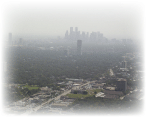PSL 2006 Texas Air Quality Study Deployment
August 7, 2006
 The NOAA Earth System Research Laboratories (ESRL), Physical Sciences Laboratory
(PSL) has deployed a variety of meteorological instruments for the 2006 Texas Air
Quality Study (TexAQS). From August through September 2006, PSL will collect a
variety of upper-air data consisting of wind and temperature profiles and integrated
water vapor. The wind profiles collected on an hourly basis are used in an
internet-based tool to calculate particle trajectories
that will support aircraft mission planning and to help scientists conduct source-receptor studies.
Surface meteorological data collected at each of the upper-air sites consists of pressure,
temperature, humidity, radiation, and rainfall. ESRL-PSL will also conduct tower-based turbulence
measurements at two sites characterized by different land use (old growth forest and
agriculture/grassland). These measurements will be used to evaluate the surface and
boundary-layer schemes used in mesoscale models. Laser instruments at these sites
will measure the instance of cloud to help interpret changes in the surface energy
budget. The datasets collected by ESRL-PSL will be used to help understand the
atmospheric processes responsible for the formation and distribution of ozone and
aerosols in the atmosphere, their influence on regional and global climate, as well
as their impact on human health and regional haze. During the same period, PSL and
the ESRL Chemical Sciences Laboratory will be collecting complementary shipboard
measurements on board the Research Vessel Ronald H. Brown. PSL shipboard
instrumentation includes a wind profiler, a radiosonde system, and an air-sea
interaction turbulence package.
The NOAA Earth System Research Laboratories (ESRL), Physical Sciences Laboratory
(PSL) has deployed a variety of meteorological instruments for the 2006 Texas Air
Quality Study (TexAQS). From August through September 2006, PSL will collect a
variety of upper-air data consisting of wind and temperature profiles and integrated
water vapor. The wind profiles collected on an hourly basis are used in an
internet-based tool to calculate particle trajectories
that will support aircraft mission planning and to help scientists conduct source-receptor studies.
Surface meteorological data collected at each of the upper-air sites consists of pressure,
temperature, humidity, radiation, and rainfall. ESRL-PSL will also conduct tower-based turbulence
measurements at two sites characterized by different land use (old growth forest and
agriculture/grassland). These measurements will be used to evaluate the surface and
boundary-layer schemes used in mesoscale models. Laser instruments at these sites
will measure the instance of cloud to help interpret changes in the surface energy
budget. The datasets collected by ESRL-PSL will be used to help understand the
atmospheric processes responsible for the formation and distribution of ozone and
aerosols in the atmosphere, their influence on regional and global climate, as well
as their impact on human health and regional haze. During the same period, PSL and
the ESRL Chemical Sciences Laboratory will be collecting complementary shipboard
measurements on board the Research Vessel Ronald H. Brown. PSL shipboard
instrumentation includes a wind profiler, a radiosonde system, and an air-sea
interaction turbulence package.
Background:
As stated on the University of Texas' TexAQS web site, "Reducing
air pollution is one of the most pressing public policy challenges facing the State of Texas.
Failure to meet federal air quality mandates will result in significant public health consequences
and hundreds of billions of dollars in lost economic development for Texas." This is the third air
quality study the state of Texas has performed since 1990. The current study is being
conducted over the period May 2005 - September 2006.
Significance:
Through better understanding of the meteorological processes
influencing air quality, how these processes differ over water and land, and the
chemical make-up and transport of pollutants, NOAA researchers are providing valuable
input for formulation of effective and efficient approaches to improve air quality.
These activities support NOAA's mission goal of serving society's needs for weather
and water information.
(Photo courtesy of University of Texas, TexAQS web site.)
| Contact: Allen White | More Information: PSL's TexAQS Page |